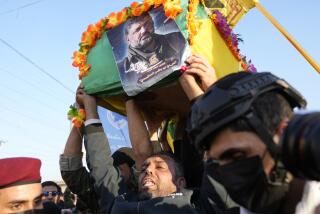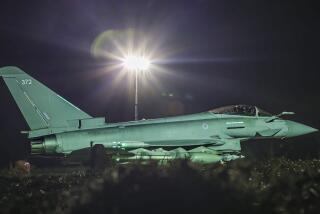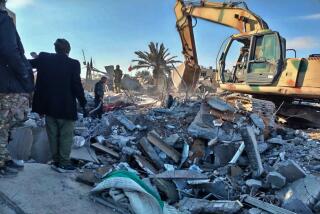Long-dead militant’s battle plan resurrected in Iraq

In early 2004, U.S. officials called a news conference in Baghdad to trumpet an intelligence coup: an intercepted letter from the head of Al Qaeda in Iraq setting forth his vision while outlining his worries about his organization’s ability to combat an improving, American-backed Iraqi security force.
A decade later, it is the United States’ turn to worry as the successors to Abu Musab Zarqawi, that now long dead militant leader, seize territory from a woefully ineffective Iraqi army and implement his extremist game plan with devastating precision.
In recent days, Sunni Muslim militants from the Islamic State of Iraq and Syria, or ISIS, have chased government forces from several key towns in western and northern Iraq, extending their geographic reach from eastern Syria to within an hour’s drive of Baghdad. On Sunday, the militants reportedly captured two more border crossings into Jordan and Syria, a day after winning a fierce, three-day battle with Iraqi security forces for Qaim, a town on the Syrian border.
President Obama said Sunday that the rapid gains by ISIS in Iraq could spill into Jordanian territory and that the group “could amass more arms, more resources” in Syria.
The advances have moved the insurgents closer to establishing the transnational Sunni caliphate based on Islamic law that Zarqawi dreamed of — and American officials once dismissed as a pipe dream.
At the same time, and also worrisome for U.S. officials: Shiite Muslim militiamen have reappeared on the streets of Baghdad and other Iraqi cities, vowing to fight the insurgents and renewing the specter of sectarian war that ISIS hopes will draw Sunni civilians to its side.
Current and former U.S. officials acknowledge that much of the vision Zarqawi outlined in his 2004 letter — when Pentagon commanders described him as “terrified” — is coming to pass.
“The developments yesterday and the past several days walk right into what ISIS has been hoping for,” said Seth Jones, a former U.S. counter-terrorism official now with the Rand Corp. think tank.
ISIS in many ways seems better equipped for a long, complex insurgency than its precursor organization of a decade ago, Zarqawi’s Al Qaeda in Iraq. Rebranded as the Islamic State of Iraq after Zarqawi was killed in a U.S. airstrike in 2006, the group exploited a U.S. military occupation to rally its fighters. Its current incarnation has railed against the Iraqi government that was formed during the U.S. occupation and has been led by Prime Minister Nouri Maliki, a Shiite who critics say has systematically marginalized minority Sunnis.
Now headed by Abu Bakr Baghdadi, a reclusive former teacher, the group added Syria to its name to reflect its widening ambitions. In March 2013, ISIS seized the Syrian city of Raqqah, the first provincial capital it held, and by taking several more cities in eastern Syria over the last year the group has gained what Zarqawi wanted but never had: a safe haven in which to hide fighters and plot major operations.
In his 2004 letter to Al Qaeda leadership, Zarqawi lamented his inability to invite large numbers of foreign Islamic militants to Iraq to help fight U.S. and Iraqi forces.
“What prevents us from [calling] a general alert is that the country has no mountains in which we can take refuge and no forests in whose thickets we can hide,” he wrote. “Our backs are exposed and our movements compromised.”
Thanks to its conquests in Syria, analysts say, ISIS has become a magnet for foreign radicals, particularly from Europe. The influx of eager fighters has allowed the group to dramatically increase the pace of its attacks in Iraq over the last 18 months even as it continues to battle President Bashar Assad’s troops in Syria.
In 2013, 277 suicide bombings occurred in Iraq, nearly all of which U.S. officials attribute to foreign militants from ISIS entering the country from Syria. In the 30 days before Iraq’s parliamentary elections in April, there were 53 suicide bombings and civilian deaths approached levels not seen since 2008.
The main target of the bombings has been Iraq’s majority Shiite community as attackers struck mosques, playgrounds and markets. The violence fit with the strategy espoused by Zarqawi a decade ago in which he called for slaughtering Shiites to provoke them into fighting back, thus drawing Sunni civilians to the militant group’s side.
“If we succeed in dragging them [Shiites] into the arena of sectarian war, it will become possible to awaken the inattentive Sunnis as they feel imminent danger,” Zarqawi wrote.
“The violence may appear indiscriminate, but it is not,” a senior U.S. diplomat in charge of Iraq policy, Brett McGurk, testified to a congressional committee this year.
In 2006, Al Qaeda in Iraq was blamed for bombing a shrine in the northern Iraqi town of Samarra, one of the holiest sites in Shiite Islam, triggering a furious response from Shiite militias and plunging Iraq into sectarian war. This time around, ISIS has again threatened to lay waste to Shiite shrines, prompting Iraq’s most influential Shiite clerics to call on followers to take up arms to defend the sites.
The largest and perhaps most fearsome demonstration of Shiite power occurred Saturday in east Baghdad, where thousands of fighters from the Mahdi Army, an officially disbanded Shiite militia, paraded in the streets with weapons. Though the Mahdi Army’s leader, the radical anti-American cleric Muqtada Sadr, said they would only defend holy sites from attack, many fighters said they were ready to kill Sunni insurgents.
“It has galvanized the dormant Shiite militias,” said Ghaffar Hussain, managing director of the Quilliam Foundation, a nonprofit organization that studies militant groups. “They are saying they’re out to defend holy sites, but if things kick off, everyone becomes a target all of a sudden and things could get really messy.”
What turned the tide against Zarqawi’s followers in the mid-2000s was a buildup of U.S. troops and an uprising by Sunni tribal leaders who grew tired of the group’s brutal tactics. Although Obama says he won’t send ground troops back into Iraq, U.S. officials hope that limited military assistance will slow ISIS’ advance and a new Iraqi government — perhaps led by someone other than Maliki — would defuse the sectarian tensions fueling ISIS’ march.
Experts believe that Iraqi Sunnis don’t support ISIS’ strict interpretation of Islamic law, which bans alcohol and cigarettes and mandates that anyone caught stealing have his hands chopped off. But after its rapid gains in recent weeks, including seizing untold millions of dollars from banks in the northern Iraqi city of Mosul, the group will probably be able to coax — or bribe — Sunni tribal leaders and civilians to its side, if only temporarily.
“They will try to bring them on board through this broader critique of the Maliki Shiite government,” said Jones, the former counter-terrorism official. “If they can’t do it that way, they will do it through fear.”
More to Read
Start your day right
Sign up for Essential California for news, features and recommendations from the L.A. Times and beyond in your inbox six days a week.
You may occasionally receive promotional content from the Los Angeles Times.







